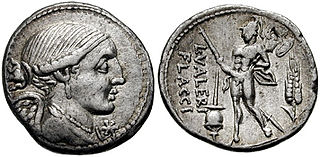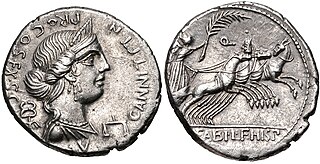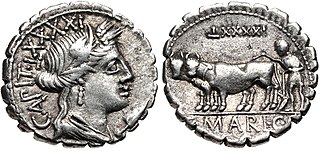Related Research Articles

The gens Valeria was a patrician family at ancient Rome, prominent from the very beginning of the Republic to the latest period of the Empire. Publius Valerius Poplicola was one of the consuls in 509 BC, the year that saw the overthrow of the Tarquins, and the members of his family were among the most celebrated statesmen and generals at the beginning of the Republic. Over the next ten centuries, few gentes produced as many distinguished men, and at every period the name of Valerius was constantly to be found in the lists of annual magistrates, and held in the highest honour. Several of the emperors claimed descent from the Valerii, whose name they bore as part of their official nomenclature.
Asinius is the nomen of the plebeian Gens Asinia of ancient Rome. Local tradition holds that the Italian town of Assignano derives its name from the gens, as well as the French town of Assignan.

The gens Julia was one of the most prominent patrician families in ancient Rome. Members of the gens attained the highest dignities of the state in the earliest times of the Republic. The first of the family to obtain the consulship was Gaius Julius Iulus in 489 BC. The gens is perhaps best known, however, for Gaius Julius Caesar, the dictator and grand uncle of the emperor Augustus, through whom the name was passed to the so-called Julio-Claudian dynasty of the first century AD. The nomen Julius became very common in imperial times, as the descendants of persons enrolled as citizens under the early emperors began to make their mark in history.

The gens Aurelia was a plebeian family at ancient Rome, which flourished from the third century BC to the latest period of the Empire. The first of the Aurelian gens to obtain the consulship was Gaius Aurelius Cotta in 252 BC. From then to the end of the Republic, the Aurelii supplied many distinguished statesmen, before entering a period of relative obscurity under the early emperors. In the latter part of the first century, a family of the Aurelii rose to prominence, obtaining patrician status, and eventually the throne itself. A series of emperors belonged to this family, through birth or adoption, including Marcus Aurelius and the members of the Severan dynasty.
Gaius Asinius Gallus was a Roman senator, son of Gaius Asinius Pollio and Quinctia. He was the second husband of Vipsania, eldest daughter of Marcus Agrippa and first wife of Tiberius, who ultimately imprisoned him.

Vipsania Agrippina was the first wife of the Emperor Tiberius. She was the daughter of Marcus Vipsanius Agrippa and Attica, thus a granddaughter of Titus Pomponius Atticus, the best friend of Cicero.

The gens Junia or Iunia was one of the most celebrated families of ancient Rome. The gens may originally have been patrician, and was already prominent in the last days of the Roman monarchy. Lucius Junius Brutus was the nephew of Lucius Tarquinius Superbus, the seventh and last King of Rome, and on the expulsion of Tarquin in 509 BC, he became one of the first consuls of the Roman Republic.

The gens Cornelia was one of the greatest patrician houses at ancient Rome. For more than seven hundred years, from the early decades of the Republic to the third century AD, the Cornelii produced more eminent statesmen and generals than any other gens. At least seventy-five consuls under the Republic were members of this family, beginning with Servius Cornelius Maluginensis in 485 BC. Together with the Aemilii, Claudii, Fabii, Manlii, and Valerii, the Cornelii were almost certainly numbered among the gentes maiores, the most important and powerful families of Rome, who for centuries dominated the Republican magistracies. All of the major branches of the Cornelian gens were patrician, but there were also plebeian Cornelii, at least some of whom were descended from freedmen.
Gaius Asinius Pollio was a Roman senator and orator active during the Principate. He was ordinary consul for 23 with Gaius Antistius Vetus as his colleague. He was the oldest son of Gaius Asinius Gallus; his brother was Marcus Asinius Agrippa, consul in 25. Pollio's mother was Vipsania Agrippina. Through her, he was the half-brother of the younger Drusus.

The gens Annia was a plebeian family at ancient Rome. Livy mentions a Lucius Annius, praetor of the Roman colony of Setia, in 340 BC, and other Annii are mentioned at Rome during this period. Members of this gens held various positions of authority from the time of the Second Punic War, and Titus Annius Luscus attained the consulship in 153 BC. In the second century AD, the Annii gained the Empire itself; Marcus Aurelius was descended from this family.

The gens Antonia was a Roman family of great antiquity, with both patrician and plebeian branches. The first of the gens to achieve prominence was Titus Antonius Merenda, one of the second group of Decemviri called, in 450 BC, to help draft what became the Law of the Twelve Tables. The most prominent member of the gens was Marcus Antonius.

The gens Maria was a plebeian family of Rome. Its most celebrated member was Gaius Marius, one of the greatest generals of antiquity, and seven times consul.
The gens Cestia was a plebeian family at ancient Rome during the later Republic, and in imperial times. The first member of the gens to obtain the consulship was Gaius Cestius Gallus in AD 35. The family's name is commemorated on two monuments, the Pons Cestius and the Pyramid of Cestius which survive into modern times.
The gens Domitia was a plebeian family at ancient Rome. The first of the gens to achieve prominence was Gnaeus Domitius Calvinus, consul in 332 BC. His son, Gnaeus Domitius Calvinus Maximus, was consul in 283, and the first plebeian censor. The family produced several distinguished generals, and towards the end of the Republic, the Domitii were looked upon as one of the most illustrious gentes.

The gens Fonteia was a plebeian family at ancient Rome. Members of this gens are first mentioned toward the end of the third century BC; Titus Fonteius was a legate of Publius Cornelius Scipio during the Second Punic War. The first of the Fonteii to obtain the consulship was Gaius Fonteius Capito, consul suffectus in 33 BC.

The gens Munatia was a plebeian family at Rome. Members of this gens are first mentioned during the second century BC, but they did not obtain any of the higher offices of the Roman state until imperial times.

The gens Stertinia was a plebeian family of ancient Rome. It first rose to prominence at the time of the Second Punic War, and although none of its members attained the consulship in the time of the Republic, a number of Stertinii were so honoured in the course of the first two centuries of the Empire.
The gens Novia was a minor plebeian family at ancient Rome. Members of this gens first appear during the final century of the Republic, but the first of the Novii to obtain the consulship was Decimus Junius Novius Priscus in AD 78.
The gens Passiena, occasionally written Passienia, Passenia, Passennia, or Passenna, was a plebeian family at ancient Rome, originally of equestrian rank, but at least one member was later admitted to the patriciate. Members of this gens appear in history from the early years of the Empire down to the third century, and several obtained the consulship, beginning with Lucius Passienus Rufus in 4 BC.
Servius Asinius Celer was a Roman senator active during the Principate. He was suffect consul in the second half of the year 38 with Sextus Nonius Quinctilianus as his colleague.
References
- 1 2 3 Dictionary of Greek and Roman Biography and Mythology, vol. I, p. 385 ("Asinia Gens").
- ↑ Silius Italicus, Punica, xvii. 453.
- ↑ Livy, Epitome 73.
- 1 2 Catullus, Carmina, 12.
- ↑ Chase, pp. 112, 113, 126.
- ↑ Dictionary of Greek and Roman Biography and Mythology, vol. III, pp. 437–439 ("Gaius Asinius Pollio", No. 1).
- ↑ Chase, pp. 109, 146, 147.
- ↑ New College Latin & English Dictionary, s. v. Gallus.
- ↑ Chase, p. 110.
- ↑ New College Latin & English Dictionary, s. v. quadratus.
- ↑ Chase, pp. 109, 111.
- ↑ New College Latin & English Dictionary, s. v. praetextatus.
- ↑ Tacitus, Annales iii. 11, xiv. 40.
- ↑ Suetonius, "The Life of Augustus", 43.
- ↑ Tacitus, Annales iv. 1.
- ↑ Pliny the Elder, xxxiii. 1. § 8.
- ↑ Tacitus, Annales iii. 75.
- ↑ Pliny the Elder, ix. 17.
- ↑ Seneca the Younger, Apocolocyntosis Divi Claudii.
- ↑ Suetonius, "The Life of Claudius", 13.
- ↑ Cassius Dio, lx. 27.
- ↑ Tacitus, Annales xiv. 48.
- ↑ Vita Persii.
- ↑ Tacitus, Historiae ii. 59.
- ↑ Cassius Dio, lxvi. 26.
- ↑ Realencyclopädie der Classischen Altertumswissenschaft, II. 2, col. 1588 ("Asinius", No. 20).
- 1 2 Pliny the Younger, Epistulae, iv. 15.
- ↑ Leunissen, Konsuln und Konsulare, p. 294.
- ↑ CIG, III. 3866.
- ↑ CIG, III. 6498.
- ↑ Cicero, Epistulae ad Atticum, v. 20.
- ↑ Cicero, Philippicae, xiii. 13.